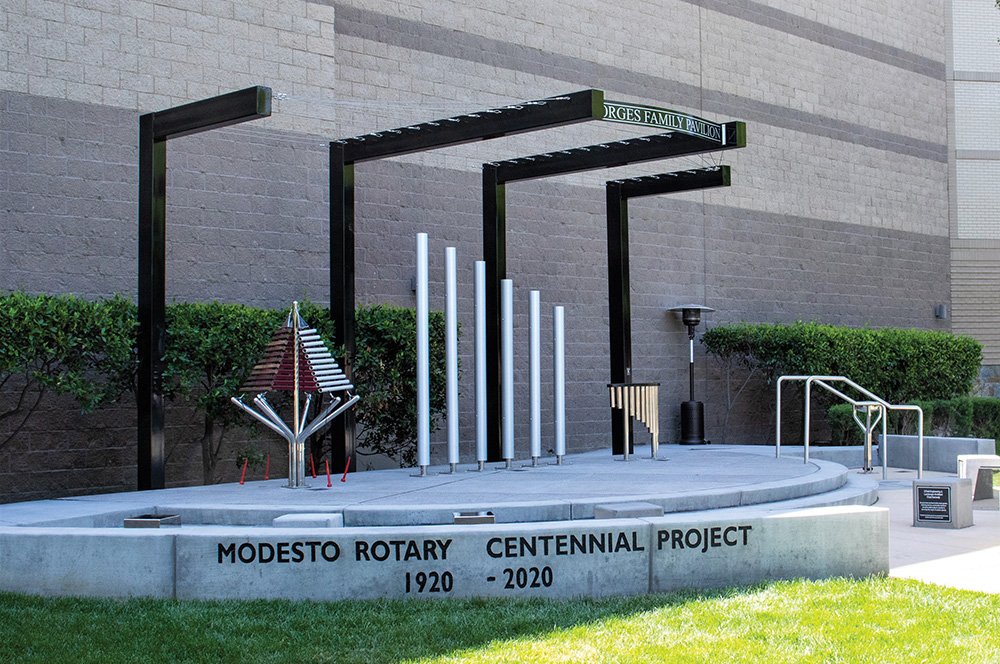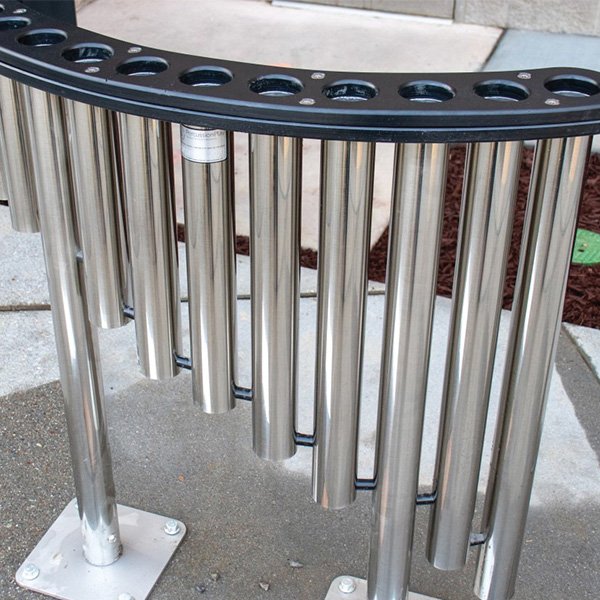Perfect Harmony
Removing barriers so all can have access to musical instruments
By Sue Murray
Photos: Gallo Center for the Arts
There are times when two projects coincide and achieve a perfect outcome. A prime example was in 2020 when the Modesto ROTARY Club (MoRo) in California was preparing to celebrate its centennial year. MoRo has supported numerous local projects, from constructing a pavilion at a downtown park and planting trees to helping the city convert an old railroad spur into a bike trail. But for this anniversary, MoRo chose an ambitious and memorable project to help beautify and revitalize the area and also improve the quality of life of its citizens. Meanwhile, Modesto’s Gallo Center for the Arts (GCA) was looking to convert a small, unused, grassy area in front of its building into a public-recreation area—a place to improve diversity by attracting the young, old, able, disabled, wealthy, and those from lower socio-economic backgrounds. Lynn Dickerson, CEO of the GCA and Phil Trompetter, MoRo president, explain how the organizations’ approaches came together for a perfect outcome.
In June 2018, Dickerson went to the Rotary International Convention in Toronto and saw Percussion Play, outdoor musical instruments that are used in a variety of environments, from schools, parks, and libraries to senior-living homes. She could immediately visualize the possibility of a vibrant, beautiful outdoor music area for both patrons and the wider community. Unlike so many public areas that offer active recreation in the form of climbing frames and slides, the instruments can be enjoyed by everyone.
Even better, this project would meet all of MoRo’s objectives:
To become a neutral ground and leveller for often separated people, where all are welcome, at no cost, in a vibrant and positive public space
To be the perfect project to mark the ROTARY club’s centennial year.
Selecting Musical Instruments
Getting everyone’s agreement on the idea of a musical garden was only the first step. Then it was time to consider the instruments, the supplier, the optimum layout for the heights of the instruments, and access for all. Since the project would be open to the wider community in an outdoor space, the instruments needed to be robust. For this reason, Dickerson and Trompetter recommended that recreation teams speak to other organizations and share their experiences. The chosen supplier provided the contact details of several organizations using its musical instruments to ensure its products were robust enough to withstand daily use and climate changes. Not all suppliers were willing to do this, but it is a highly recommended step in the selection process.
Considerations And Cost
The next step was reviewing the budget. Taking the objectives under advisement, the supplier recommended the optimum selection of instruments. Visiting the supplier’s website to look at photos and videos of the various instruments proved to be a vital part of the project. Knowing the direction of the foot traffic through and around the garden area made it possible to work with the supplier to create the ultimate layout.
Visualizing the layout highlighted a few challenges that needed to be addressed. To achieve the optimum design, some things needed to be demolished and earth needed to be moved. Walls, steps, and seats were added for people to sit and relax and listen to the music. One tree had to be relocated (it was right next to a water hydrant), which led to irrigation repairs; to make the area safe for children during construction, a temporary fence and traffic control also were incorporated. The total cost for the work and the instruments was more than $250,000, more money than was originally budgeted, but looking back, the team had an opportunity to plan for the ultimate design.
Finding Funding
Since the two organizations did not have enough initial money for the project, they began fundraising. Small donations came in from local Rotarians and community members, along with a few generous donors, such as the Porges Family Foundation, which made a significant donation. The seven instruments were sponsored by local families or companies, whose contributions ranged from $3,500 to $15,000 per instrument. Reaching out to the local community also garnered support from a landscape architect, Chad Kennedy, who designed and helped install the Music Garden free of charge.
Access For Everyone
One of the most important objectives was making this a place for everyone. Included in the layout was a consideration for wheelchair access and that the instruments were of different heights to suit all ages and abilities.
Another important consideration was the production of sound. The instruments needed to produce a positive, beautiful sound if people were to be attracted to use them. This was another reason the Percussion Play instruments were selected; whether someone is musically inclined or not, the instruments are not intimidating (as many are in a pentatonic scale). Regardless of the number of people playing the range of instruments, they always sound harmonious.
In April, the music garden was unveiled at a grand opening with local residents and dignitaries, including the county supervisors, city mayor, and a state assemblyman.
Other Challenges
Through the guidance and management of the supplier, the project ran smoothly. However, there were some unavoidable, COVID-related problems. These included the low supply of concrete and 19 incorrectly manufactured aluminium components for one of the artistic sidewalks, both of which caused a delay of a few weeks. Having the right, capable contractor on board made the whole process much easier.
Since then, the music garden has been enjoyed by many, including the Downtown Streets Team (an organization that helps the homeless with basic needs and access to employment), downtown workers on their lunch breaks, and families with children. A Summer Brown Bag concert series has proven quite popular, attracting more than 75 lunchtime attendees on a series of Fridays. Some people have been lucky enough to witness an incredible 12-year-old autistic and blind girl going all out on the drums, producing the most beautiful sound, with the older community playing alongside. The instruments are accessible to children from the poorest parts of town who previously had no free access to play these highly visual, outdoor instruments. Above all, the architectural design makes the experience accessible to people in wheelchairs.
Today, the programs inside and outside the Gallo Center for the Arts continue to reflect the interests, diversity, and history of the people who call the Central Valley their home. It now has the perfect landmark in the region for everyone to enjoy for decades to come.
Sue Murray is the Director of PLMR Mango Marketing, a marketing and PR firm. Reach her at sue.murray@mangomarketing.com.


